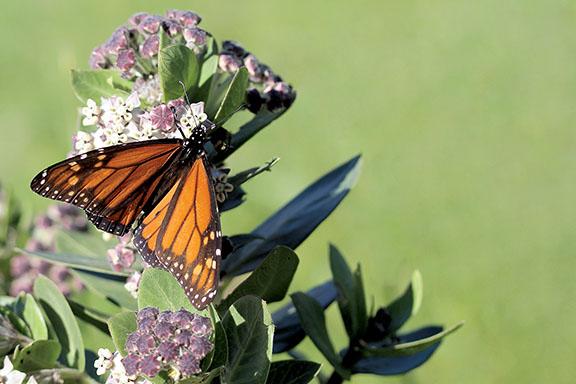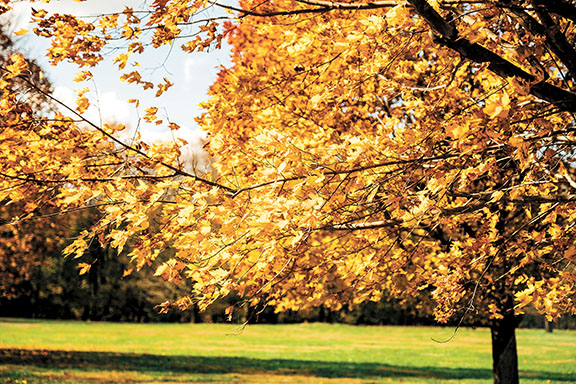
By Jody Sackett, Rumson Environmental Commission
Although the calendar would deny it, fall seems like the beginning of a new year. There’s so much new stuff happening, especially back to school. Autumn is like the start of a new year for wildlife, too, with migrations beginning for birds and marine creatures, daylight shrinking, and trees changing colors in the cooler weather. We know what fall means for people – but let’s dig in here to see what autumn means in nature.

Fall is Time to Fly South. Believe it or not, September is launching time for many birds: ducks, geese and of course our beloved coastal bird, the osprey. Their babies are now grown, flying, and trained to hunt, so it’s time for them to head south to Florida or Central/South America. Although monogamous for life, the female osprey leaves the nest first at the end of September, followed by the male about a month later. Both overwinter in different places but will return to mate in the same northern nest.
About 75% of North American birds migrate and, since we are fortunate to live along the coastal Atlantic Flyway, we have a front row seat to view many migrating birds.
Fun stuff: Snap a photo or keep a list of the birds you see around your neighborhood or near waterways and you’ll discover how transient our local feathered friends truly are. You may want to be a citizen scientist and share your info on iNaturalist or eBird. Don’t forget to get winter birdfeeders ready for our resident birds, though.
Fall is Time to Swim South. Leatherback sea turtles and whale pods are legendary for their long ocean migrations. But local anglers know fall is time to fish for those big striped bass or bluefish that are now migrating toward the Chesapeake and Virginia. Sometimes nicknamed the Migratory Blueway, stripers and bluefish love this migration path along the Atlantic Coast as they swim from cooler to warmer waters, feeding on pods of baitfish along the way.
Fall is Cocooning Time. While not all butterflies migrate, the most famous is undoubtedly the astounding monarch. Fat caterpillars, who grew from tiny whitish eggs laid on milkweed, pupate in their chrysalis and emerge in late summer as gorgeous butterflies, ready by fall to fly 2,500 miles south to central Mexico or to California. Late September or October is peak migration season, so look for dozens of them resting on seaside goldenrod along our coast, enjoying the nectar of the yellow flowers.

Fun Stuff: Create your own butterfly farm using an inexpensive plastic lidded aquarium (the 2- or 3-gallon size) for the “farm.” In September, search for common yellow and black striped black swallowtail butterfly caterpillars, who love to eat garden parsley, dill, carrot tops and Queen Anne’s Lace. Put the caterpillars and plenty of the plants they’re eating in your “farm,” along with some longer twigs. Replace the food every other day, and sprinkle a tad bit of water over it. When the larvae get big, they’ll crawl to a twig and form a “J” shape, at- tached by a thin thread; this means they are about to pu- pate. Watch them make their cocoon, which will change from bright green to “twig brown” when it’s finished. The caterpillars basically dissolve into a nutrient soup inside the cocoon and, after a few weeks, the butterflies will emerge, ready to fly. You can safely release them then. If the caterpillars pupate late in the chilly fall, they will go dormant until spring. Put your “farm” with the dormant cocoons in your cold garage over the winter, so they can safely emerge as butterflies in the warm springtime.
Fall is Leaf Coloring Time. Local plants, from trees to marsh grasses, begin to show off their fall colors as chlorophyll production declines because of decreased daylight and cooler temperatures. Lucky for us, it’s easier to spot pesky poison ivy now as the leaves become a brilliant red in autumn. Since wildlife always need food, leave some dead leaves on the ground for insects to eat, which will attract hungry birds and small mammals, too.
Fun Stuff: Adopt a tree – or three – in your yard, and take one photo of it every two weeks or so until next summer, to really see how your adopted darling changes with the seasons.
Bye-Bye Daylight. During autumn, the tilt of the Earth means the sun’s light hits the Earth lower on the horizon, resulting in a longer, weaker ray of light. We’ll have less daylight, longer shadows and more night sky. The Earth’s position changes as it orbits the sun, so the constellations in the autumn night sky will also change, with new ones appearing now.
Fun Stuff: Using a stargazing app, find the planets and stars, and see how many zodiac shapes you can find in autumn that weren’t there in summertime.

Three Ways To Be Sustainable This Autumn
1. Back to school doesn’t have to mean back to habits that aren’t Earth-friendly. Before purchasing new supplies, check your household inventory to see what you have – you might not actually need much – and be sure to choose eco-friendly supplies. Recycle the old stuff with TerraCycle. A reusable water bottle replaces endless plastic waste and bottle-filling stations are popping up everywhere now. And use brown paper bags for lunch or, even better, a more sustainable insulated lunch bag. Ditch the plastic sandwich bags for a reusable container.
2. Plog along. In Sweden, hikers routinely “plog” or pick up trash as they travel. Plastic is deadly to wildlife, who get caught in it or consume it by mistake. Whenever you are walking around, pick up two discarded plastic items you see on the ground and dispose of it properly. That’s two fewer pieces of plastic that could have harmed wildlife or polluted the waterways. If you do this every day, in just one year you’d vastly improved the Earth by cleaning up 730 bits of icky plastic with minimal effort. Imagine if you got your friends to help, too!
3. Use less light to aid migration. Most birds migrate during the longer autumn nights, so leaving our suburban outdoor night lights on hurts them by causing migration disorientation and collisions. We don’t need outdoor lights when we’re in bed, so let’s turn them off – or at least use timers or motion detector lights instead.
The article originally appeared in the September 22 – 28, 2022 print edition of The Two River Times.














